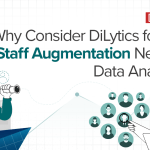Data analytics is a process of analyzing raw data that is collected, stored, and processed. The goal of data analytics is to identify patterns and trends that can be used to improve decision-making. It is used by organizations to take data driven decisions helping drive operational performance and decrease costs. Some of the data analytics techniques include data mining, data cleansing, data modeling, data transformation, machine learning, and statistical analysis.
Types of Data Analytics
Data Analytics can be classified into 4 types:
Descriptive Analytics: It tells you what has happened. Exploratory data analysis is used to perform this type of analysis. Example: Total profit made based on the sales over a period of time.
Diagnostics Analysis: It is about breaking down the available information and identifying the causes behind specific problems, events, and behaviors
Predictive Analytics: It tells you what will happen. This can be achieved by building predictive models. Example: Predicting the total profit in the future based on the future estimated sales.
Prescriptive Analytics: It tells you how to make something happen. This is done by deriving key insights and hidden patterns from the data. Example: Finding ways to improve sales and profit.
Data Analytics process steps:
There are primarily five steps involved in the data analytics process, which include:
Data Collection: The first step in data analytics is to gather relevant data from multiple sources. Data can come collected from different databases, web servers, log files, social media, excel and CSV files, etc.
Data Preparation: The next step in the process is to prepare the data. It involves cleaning the data to remove unwanted and redundant values, converting it into the right format, and making it ready for analysis. It also requires data wrangling.
Data Exploration: After the data is ready, data exploration is done using various data visualization techniques to find unseen trends from the data.
Predictive Models : The next step is to build your predictive models using machine learning algorithms to analyze and forecast the future.
Result interpretation: The final step in any data analytics process is to derive meaningful results and check if the output is in line with your expected results.
Data Analytics Tools:
Data Analytics has a wide range of tools available for analysis collecting, storing and processing data. Below are some of the popular tools:
Apache Spark: Apache Spark is an open-source analytics and data processing engine used to work with large-scale, distributed datasets and big data work loads. It is used by data scientists and developers to rapidly perform ETL jobs on large-scale data from IoT devices, sensors, etc.
Python: An open source programming language that helps users extract, summarize, and visualize data. Python provides a range of libraries like NumPy, Pandas, Matplotlib, etc.
R: An open source data analytics tool for statistical analysis and graphical modeling
Informatica: It is an integration tool used for extracting raw data, transforming the data by applying rules and loading the data to the target database for analysis.
Power BI: Microsoft’s data visualization and analysis tool for creating and distributing reports and dashboards.
Tableau: Data analysis software from Salesforce for creating dashboards, maps, and visualizations from data
Oracle Analytics cloud (OAC): Oracle Analytics supports the entire analytics workflow, offering a variety of ways to connect, prepare, and analyze data.
Data Analytics applications:
In today’s world, Data analytics has applications in various departments across all industries.
- Manufacturing: Data Analytics is used in the manufacturing industry to help produce finished goods per Supply Chain Plan.
- Pharma and Life sciences: These industries use data analytics to perform what-if analysis of the inventory based on the demand forecast.
- The Asset leasing industry: uses data analytics to track asset Lease-outs, Turn-Ins, Bookings & Container Utilization.
- Hi Tech industry: uses data analytics to analyze Sales Opportunities, Booking, Billing and Backlog (BBB), Inventory and Shop floor operations.
- Sales and Marketing: Data analytics can be used to analyze customer data, such as buying habits, to identify areas for improvement in the sales process and target marketing efforts more effectively.
- Financial Management: Data analytics can be used to analyze financial data, such as expenses and revenue, to identify areas for cost reduction and increase profitability.
- Supply Chain Management: Data analytics can be used to analyze supply chain data, such as inventory levels and shipping data, to improve operations and reduce waste.
Benefits of Data Analytics:
- Improved Decision Making: Data analytics provides organizations with the insights they need to make informed decisions, based on real data. This helps organizations make data-driven decisions, rather than relying on intuition or guesses.
- Increased Efficiency: Data analytics can help organizations automate processes, reducing manual data entry and freeing up time for more important tasks.
- Better Customer Understanding: Data analytics can be used to understand customer behavior and preferences, allowing organizations to provide better customer service and target their marketing efforts more effectively.
- Improved Operations: Data analytics can be used to identify areas for improvement within an organization, helping to streamline processes, reduce waste, and improve efficiency.
- Increased Profitability: Data analytics can be used to identify areas where an organization can increase its revenue or reduce its costs, leading to increased profitability.
Conclusion
In conclusion, data analytics is a critical tool for organizations looking to gain a competitive edge. In a world where every company has an abundance of information, data analytics can help collect, analyze, and share data from various sources using a variety of tools and techniques. Data Analytics helps organizations identify patterns in data that can help optimize decision making and decrease cost. With the increasing amount of data being generated every day, organizations are turning to data analytics to help them make informed decisions and stay ahead of the competition.
To implement data analytics for your organization or for any queries, you can reach out to us at [email protected]





